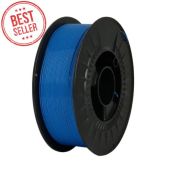We use cookies to make your experience better. Read more
- Read more
PLA Filament Temperature: How to Achieve the Best Print Quality
Getting the PLA filament temperature just right is one of the most important aspects of successful 3D printing. Whether you're printing simple models or intricate, detailed designs, fine-tuning your temperature settings can drastically improve both the quality and reliability of your results. From bed adhesion to structural integrity, temperature affects almost every stage of the 3D printing process.
Why Temperature Matters in 3D Printing
Correct temperature settings are essential to melt the filament properly and ensure it flows smoothly through the nozzle. If the filament is too cold, it won’t extrude consistently. Too hot, and you might encounter stringing, blobs, or even structural defects.
- Layer adhesion
- Surface finish
- Print warping
- Print bed adhesion
- Nozzle flow rate
Each of these factors directly impacts the final look and strength of the printed object. For materials like PLA, the temperature range for the nozzle typically
-
TPU Filament Uses: Flexible Solutions for Complex Projects
18 April, 2025Read moreTPU Filament Uses: Flexible Solutions for Complex Projects
What is TPU Filament and Why is it So Widely Used?
TPU filament, short for Thermoplastic Polyurethane, is a flexible 3D printing material that combines the strength of plastic with the elasticity of rubber. As a member of the thermoplastic elastomer (TPE) family, TPU stands out for its resilience, stretchability, and versatility across both consumer and industrial applications. Its popularity stems from the fact that it can stretch over five times its original length before breaking, making it a top choice for applications that require flexibility and durability.
Key Properties of TPU Filament
Parts printed with TPU filament exhibit a range of beneficial properties, including excellent shock absorption, impact resistance, vibration dampening, and elasticity. Additionally, TPU is highly resistant to abrasions, oils, greases, chemicals, low temperatures, and shows moderate water resistance. Manufacturers can adjust the hardness and
- Read more
How to Print ASA Filament: A Practical Guide for Durable Prints
ASA filament is one of the top choices when it comes to printing strong, weather-resistant 3D models. While it shares some characteristics with ABS, it offers significantly better UV and weather resistance, making it perfect for outdoor use. If you're looking to master how to print ASA filament without dealing with issues like warping or poor adhesion, this guide is for you.
What Makes ASA Filament Different?
Acrylic Styrene Acrylonitrile (ASA) is an engineering thermoplastic similar in structure to ABS. However, it was developed specifically to improve upon ABS by enhancing its weather resistance and UV stability. That makes ASA ideal for outdoor parts such as automotive components, garden tools, dashboard panels, and boat fittings.
- Acrylonitrile: Provides chemical and heat resistance.
- Styrene: Adds rigidity and dimensional stability.
- Acrylate: Enhances impact strength and weather resistance.
Its glass transition temperature
-
How to Print PETG: Mastering a Durable 3D Filament
18 April, 2025Read moreHow to Print PETG: Mastering a Durable 3D Filament
Understanding PETG and Why It Matters
PETG (Polyethylene Terephthalate Glycol) is a glycol-modified version of the common PET material, best known for its role in plastic bottles. This modification makes PETG clearer, more temperature-resistant, and easier to extrude in 3D printing. A blend of PLA’s ease of use and ABS’s toughness, PETG is a favorite among those who require durability, chemical resistance, and visual appeal in their 3D prints.
It’s often used in both artistic and functional applications, such as protective casings, mechanical parts, display items, and containers. Thanks to its impact strength and chemical resistance, PETG is also well-suited for outdoor use and even food-safe applications (depending on the manufacturer).
Print Settings: The Essentials for PETG
Getting great results with PETG depends on dialing in the right print settings. Here's what to focus on:
- Temperature Range
Extruder temperature: 220-260°C
Bed temperature:
- Temperature Range
- Read more
PLA Filament Temperature: How to Achieve the Best Print Quality
Getting the PLA filament temperature just right is one of the most important aspects of successful 3D printing. Whether you're printing simple models or intricate, detailed designs, fine-tuning your temperature settings can drastically improve both the quality and reliability of your results. From bed adhesion to structural integrity, temperature affects almost every stage of the 3D printing process.
Why Temperature Matters in 3D Printing
Correct temperature settings are essential to melt the filament properly and ensure it flows smoothly through the nozzle. If the filament is too cold, it won’t extrude consistently. Too hot, and you might encounter stringing, blobs, or even structural defects.
- Layer adhesion
- Surface finish
- Print warping
- Print bed adhesion
- Nozzle flow rate
Each of these factors directly impacts the final look and strength of the printed object. For materials like PLA, the temperature range for the nozzle typically
-
TPU Filament Uses: Flexible Solutions for Complex Projects
18 April, 2025Read moreTPU Filament Uses: Flexible Solutions for Complex Projects
What is TPU Filament and Why is it So Widely Used?
TPU filament, short for Thermoplastic Polyurethane, is a flexible 3D printing material that combines the strength of plastic with the elasticity of rubber. As a member of the thermoplastic elastomer (TPE) family, TPU stands out for its resilience, stretchability, and versatility across both consumer and industrial applications. Its popularity stems from the fact that it can stretch over five times its original length before breaking, making it a top choice for applications that require flexibility and durability.
Key Properties of TPU Filament
- Excellent shock absorption, impact resistance, and vibration dampening
- High elasticity and resilience
- Resistance to abrasions, oils, greases, chemicals, and low temperatures
- Moderate water resistance
- Adjustable hardness and flexibility depending on infill and filament type
Color and Printing Considerations
TPU can be printed in many colors,
- Read more
How to Print ASA Filament: A Practical Guide for Durable Prints
ASA filament is one of the top choices when it comes to printing strong, weather-resistant 3D models. While it shares some characteristics with ABS, it offers significantly better UV and weather resistance, making it perfect for outdoor use. If you're looking to master how to print ASA filament without dealing with issues like warping or poor adhesion, this guide is for you.
What Makes ASA Filament Different?
Acrylic Styrene Acrylonitrile (ASA) is an engineering thermoplastic similar in structure to ABS. However, it was developed specifically to improve upon ABS by enhancing its weather resistance and UV stability. That makes ASA ideal for outdoor parts such as automotive components, garden tools, dashboard panels, and boat fittings.
- Acrylonitrile: Provides chemical and heat resistance.
- Styrene: Adds rigidity and dimensional stability.
- Acrylate: Enhances impact strength and weather resistance.
Its glass transition temperature
-
How to Store PLA Filament for Optimal 3D Printing Results
16 April, 2025Read moreHow to Store PLA Filament for Optimal 3D Printing Results
Proper storage of PLA filament is essential to ensure consistent and high-quality 3D printing results. Neglecting this critical step can lead to brittle materials, poor print quality, and even damage to your 3D printer. This guide will walk you through why proper PLA filament storage matters and provide practical tips to keep your filament in top condition.
Why Is Proper Storage Important for PLA Filament?
PLA filament, widely used in 3D printing, is a biodegradable plastic made from renewable resources like corn starch and sugarcane. Its versatility and eco-friendliness make it a popular choice, but its hygroscopic nature—the tendency to absorb moisture from the air—makes proper storage crucial.
Key Reasons to Store PLA Filament Correctly:
- Prevent Moisture Damage: PLA absorbs moisture, which can lead to bubbling, uneven layers, and poor adhesion during printing.
- Maintain Print Quality: Exposure to moisture affects filament consistency,
- Read more
ASA Filament vs PETG Filament: Which is Right for Your 3D Printing Needs?
When choosing a 3D printing filament, two popular options stand out: ASA filament and PETG filament. Each has unique properties, advantages, and ideal applications. In this guide, we’ll explore the differences between ASA and PETG, helping you determine the best material for your specific project.
Understanding ASA Filament
ASA (Acrylonitrile Styrene Acrylate) is a thermoplastic designed for durability and weather resistance. Originally developed as an alternative to ABS, ASA excels in outdoor applications due to its superior UV resistance and impact strength.
Key Features of ASA Filament
- UV Resistance: ASA retains its color and structure even under prolonged sunlight exposure, making it perfect for outdoor use.
- High Impact Strength: With excellent resistance to physical stress, ASA is ideal for rugged parts.
- Temperature Resistance: ASA has a high glass transition temperature of around 105°C, enabling it to withstand
-
PETG Filament: Exploring Temperature Resistance
16 April, 2025Read morePETG Filament: Exploring Temperature Resistance
Polyethylene Terephthalate Glycol-modified, or PETG, is one of the most popular materials in 3D printing, celebrated for its durability, transparency, and ease of use. This article dives deep into the temperature resistance of PETG filament, examining its strengths, limitations, and applications while keeping a focus on its relevance for technical parts and other demanding uses.
PETG Temperature Resistance: A Key Advantage
One of the defining attributes of PETG filament is its superior temperature resistance compared to many other 3D printing materials, such as PLA. PETG maintains its mechanical properties and shape integrity at temperatures up to 70°C, making it suitable for various interior and exterior applications. This resistance to heat degradation stems from its molecular structure, which includes modifications with glycol to enhance its stability and reduce brittleness.
Why Temperature Resistance Matters
Temperature resistance is



Please complete your information below to login.
Sign In
Create New Account